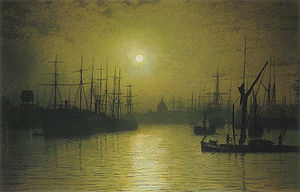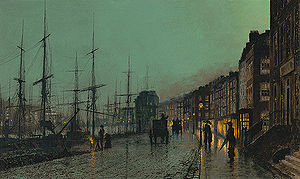
John Atkinson Grimshaw
Encyclopedia
John Atkinson Grimshaw was a Victorian-era artist, a "remarkable and imaginative painter" known for his city night-scenes and landscapes.
His early paintings were signed "JAG," "J. A. Grimshaw," or "John Atkinson Grimshaw," though he finally settled on "Atkinson Grimshaw."
. In 1856 he married his cousin Frances Hubbard (1835-1917). In 1861, at the age of 24, to the dismay of his parents, he left his first job as a clerk for the Great Northern Railway
to become a painter. He began exhibiting in 1862, under the patronage of the Leeds Philosophical and Literary Society, with paintings mainly of birds, fruit, and blossoms. He became particularly successful in the 1870s and began to rent a second home in Scarborough, which also became a favourite subject.
Several of his children, Arthur Grimshaw (1864–1913), Louis H Grimshaw (1870–1944), Wilfred Grimshaw (1871–1937) and Elaine Grimshaw (1877–1970), also became painters.
 Grimshaw's primary influence was the Pre-Raphaelites
Grimshaw's primary influence was the Pre-Raphaelites
. True to the Pre-Raphaelite style, he created landscapes of accurate colour and lighting, and vivid detail. He often painted landscapes that typified seasons or a type of weather; city and suburban street scenes and moonlit views of the docks in London, Leeds, Liverpool, and Glasgow also figured largely in his art. His careful painting and skill in lighting effects meant that he often captured both the appearance and the mood of a scene in minute detail. His "paintings of dampened gas-lit streets and misty waterfronts conveyed an eerie warmth as well as alienation in the urban scene."
Dulce Domum (1855), on whose reverse Grimshaw wrote, "mostly painted under great difficulties," captures the music portrayed in the piano-player, entices the eye to meander through the richly decorated room, and to consider the still and silent young lady who is listening. Grimshaw painted more interior scenes, especially in the 1870s, when he worked under the influence of James Tissot
and the Aesthetic Movement.
On Hampstead Hill is considered one of Grimshaw's finest, exemplifying his skill with a variety of light sources, in capturing the mood of the passing of twilight into night. In his later career his urban scenes under twilight or yellow streetlighting were highly popular, especially with his middle-class patrons.
His later work included imagined scenes from the Greek and Roman empires, and he also painted literary subjects from Longfellow
and Tennyson
—pictures including Elaine and The Lady of Shalott. (Grimshaw named all of his children after characters in Tennyson's poems.)
In the 1880s, Grimshaw maintained a London studio in Chelsea
, not far from the comparable studio of James Abbott McNeill Whistler. After visiting Grimshaw, Whistler remarked that "I considered myself the inventor of Nocturnes until I saw Grimmy's moonlit pictures." Unlike Whistler's Impressionistic
night scenes, however, Grimshaw worked in a realistic vein: "sharply focused, almost photographic," his pictures innovated in applying the tradition of rural moonlight images to the Victorian city, recording "the rain and mist, the puddles and smoky fog of late Victorian industrial England with great poetry."
 Grimshaw's paintings depicted the modern world but eschewed the dirty and depressing aspects of industrial towns. Shipping on the Clyde for instance, a depiction of Glasgow's Victorian docks, is a lyrically beautiful evocation of the industrial era. Grimshaw transcribed the fog and mist so accurately as to capture the chill in the damp air, and the moisture penetrating the heavy clothes of the few figures awake in the misty early morning.
Grimshaw's paintings depicted the modern world but eschewed the dirty and depressing aspects of industrial towns. Shipping on the Clyde for instance, a depiction of Glasgow's Victorian docks, is a lyrically beautiful evocation of the industrial era. Grimshaw transcribed the fog and mist so accurately as to capture the chill in the damp air, and the moisture penetrating the heavy clothes of the few figures awake in the misty early morning.
Some artists of Grimshaw's period, like Vincent Van Gogh
and James Smetham
, left many letters and other documents recording their work and lives. Others, like Edward Pritchett
, left nothing. Grimshaw left behind no letters, journals, or papers; scholars and critics have little material on which to base their understanding of his life and career.
Grimshaw died 13 October 1893, and is buried in Woodhouse Hill Cemetery, Hunslet, Leeds. His reputation rested, and his legacy is probably based on, his townscapes. There was a major revival of interest in Grimshaw's work in the second half of the 20th century, with several important exhibitions devoted to it. A new retrospective exhibition Atkinson Grimshaw – Painter of Moonlight ran from 16 April 2011 to 4 September 2011 at Mercer Art Gallery in Harrogate
and subsequently in the Guildhall Gallery, London.
His early paintings were signed "JAG," "J. A. Grimshaw," or "John Atkinson Grimshaw," though he finally settled on "Atkinson Grimshaw."
Life
He was born 6 September 1836 in LeedsLeeds
Leeds is a city and metropolitan borough in West Yorkshire, England. In 2001 Leeds' main urban subdivision had a population of 443,247, while the entire city has a population of 798,800 , making it the 30th-most populous city in the European Union.Leeds is the cultural, financial and commercial...
. In 1856 he married his cousin Frances Hubbard (1835-1917). In 1861, at the age of 24, to the dismay of his parents, he left his first job as a clerk for the Great Northern Railway
Great Northern Railway (Great Britain)
The Great Northern Railway was a British railway company established by the Great Northern Railway Act of 1846. On 1 January 1923 the company lost its identity as a constituent of the newly formed London and North Eastern Railway....
to become a painter. He began exhibiting in 1862, under the patronage of the Leeds Philosophical and Literary Society, with paintings mainly of birds, fruit, and blossoms. He became particularly successful in the 1870s and began to rent a second home in Scarborough, which also became a favourite subject.
Several of his children, Arthur Grimshaw (1864–1913), Louis H Grimshaw (1870–1944), Wilfred Grimshaw (1871–1937) and Elaine Grimshaw (1877–1970), also became painters.
Work

Pre-Raphaelite Brotherhood
The Pre-Raphaelite Brotherhood was a group of English painters, poets, and critics, founded in 1848 by William Holman Hunt, John Everett Millais and Dante Gabriel Rossetti...
. True to the Pre-Raphaelite style, he created landscapes of accurate colour and lighting, and vivid detail. He often painted landscapes that typified seasons or a type of weather; city and suburban street scenes and moonlit views of the docks in London, Leeds, Liverpool, and Glasgow also figured largely in his art. His careful painting and skill in lighting effects meant that he often captured both the appearance and the mood of a scene in minute detail. His "paintings of dampened gas-lit streets and misty waterfronts conveyed an eerie warmth as well as alienation in the urban scene."
Dulce Domum (1855), on whose reverse Grimshaw wrote, "mostly painted under great difficulties," captures the music portrayed in the piano-player, entices the eye to meander through the richly decorated room, and to consider the still and silent young lady who is listening. Grimshaw painted more interior scenes, especially in the 1870s, when he worked under the influence of James Tissot
James Tissot
James Jacques Joseph Tissot was a French painter, who spent much of his career in Britain.-Biography:Tissot was born in Nantes, France. In about 1856, he began study at the École des Beaux-Arts in Paris under Hippolyte Flandrin and Lamothe, and became friendly with Edgar Degas and James Abbott...
and the Aesthetic Movement.
On Hampstead Hill is considered one of Grimshaw's finest, exemplifying his skill with a variety of light sources, in capturing the mood of the passing of twilight into night. In his later career his urban scenes under twilight or yellow streetlighting were highly popular, especially with his middle-class patrons.
His later work included imagined scenes from the Greek and Roman empires, and he also painted literary subjects from Longfellow
Henry Wadsworth Longfellow
Henry Wadsworth Longfellow was an American poet and educator whose works include "Paul Revere's Ride", The Song of Hiawatha, and Evangeline...
and Tennyson
Alfred Tennyson, 1st Baron Tennyson
Alfred Tennyson, 1st Baron Tennyson, FRS was Poet Laureate of the United Kingdom during much of Queen Victoria's reign and remains one of the most popular poets in the English language....
—pictures including Elaine and The Lady of Shalott. (Grimshaw named all of his children after characters in Tennyson's poems.)
In the 1880s, Grimshaw maintained a London studio in Chelsea
Chelsea, London
Chelsea is an area of West London, England, bounded to the south by the River Thames, where its frontage runs from Chelsea Bridge along the Chelsea Embankment, Cheyne Walk, Lots Road and Chelsea Harbour. Its eastern boundary was once defined by the River Westbourne, which is now in a pipe above...
, not far from the comparable studio of James Abbott McNeill Whistler. After visiting Grimshaw, Whistler remarked that "I considered myself the inventor of Nocturnes until I saw Grimmy's moonlit pictures." Unlike Whistler's Impressionistic
Impressionism
Impressionism was a 19th-century art movement that originated with a group of Paris-based artists whose independent exhibitions brought them to prominence during the 1870s and 1880s...
night scenes, however, Grimshaw worked in a realistic vein: "sharply focused, almost photographic," his pictures innovated in applying the tradition of rural moonlight images to the Victorian city, recording "the rain and mist, the puddles and smoky fog of late Victorian industrial England with great poetry."

Some artists of Grimshaw's period, like Vincent Van Gogh
Vincent van Gogh
Vincent Willem van Gogh , and used Brabant dialect in his writing; it is therefore likely that he himself pronounced his name with a Brabant accent: , with a voiced V and palatalized G and gh. In France, where much of his work was produced, it is...
and James Smetham
James Smetham
James Smetham was an English Pre-Raphaelite painter and engraver, a follower of Dante Gabriel Rossetti....
, left many letters and other documents recording their work and lives. Others, like Edward Pritchett
Edward Pritchett
Edward Pritchett was a nineteenth-century English painter and man of mystery.Nothing is known of Pritchett's life; he has appropriately been described as "elusive." He may have lived to 1879...
, left nothing. Grimshaw left behind no letters, journals, or papers; scholars and critics have little material on which to base their understanding of his life and career.
Grimshaw died 13 October 1893, and is buried in Woodhouse Hill Cemetery, Hunslet, Leeds. His reputation rested, and his legacy is probably based on, his townscapes. There was a major revival of interest in Grimshaw's work in the second half of the 20th century, with several important exhibitions devoted to it. A new retrospective exhibition Atkinson Grimshaw – Painter of Moonlight ran from 16 April 2011 to 4 September 2011 at Mercer Art Gallery in Harrogate
Harrogate
Harrogate is a spa town in North Yorkshire, England. The town is a tourist destination and its visitor attractions include its spa waters, RHS Harlow Carr gardens, and Betty's Tea Rooms. From the town one can explore the nearby Yorkshire Dales national park. Harrogate originated in the 17th...
and subsequently in the Guildhall Gallery, London.
Further Reading
- Alexander Robertson, Atkinson Grimshaw, London, Phaidon Press, 1996 ISBN 0 7148 2525 5
External links
- Atkinson Grimshaw
- A collection of Grimshaw paintings
- Royal Academy biography
- Johnatkinsongrimshaw.org 85 works by John Atkinson Grimshaw
- Shipping on the Clyde in Glasgow from Grimshaw, a Thyssen Museum's project on Flickr
- Artcyclopedia.com
- Phryne's list of paintings by Grimshaw in accessible collections in the UK
- Paintings Leeds Collection
- Mercer Art Gallery, Harrogate where the Atkinson Grimshaw – Painter of Moonlight exhibition is running from 16 April to 4 September 2011

